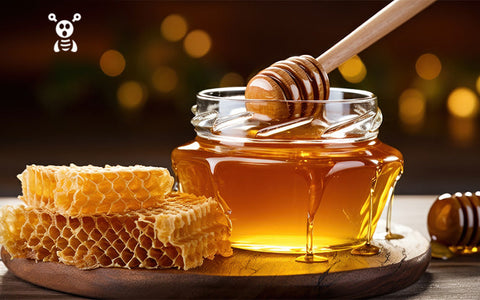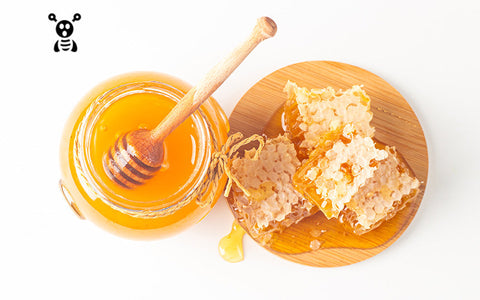Key Takeaways
- What is mad honey? It’s a rare Himalayan honey containing grayanotoxins, known for mild psychoactive effects when consumed in small amounts.
- Not all mad honey is dangerous. Safe consumption depends on following the recommended dose and choosing a reputable, verified source.
- While traditionally used for certain ailments, mad honey is not a substitute for medical treatment.
- Authenticity matters. Look for lab-tested honey from Nepal with verified Rhododendron pollen content for the real experience.
Exploring the Facts Behind Hallucinogenic Honey from Nepal

Harvested high in the Himalayas and known for its psychoactive properties, mad honey has inspired centuries of fascination, myth, and controversy. Prized for its unique properties and cultural significance, it continues to intrigue adventurous foodies and curious minds alike. But how much of what we’ve heard is based on fact, and how much is folklore?
In this article, we break down the most common myths about what mad honey is, drawing the line between tale and truth so you can make an informed decision.
Myth #1: Mad Honey Causes Bad Trips or Intense Hallucinations
Some individuals mistakenly believe that mad honey sends users into uncontrollable psychedelic episodes. But what is mad honey really like in practice?
While it’s true that this type of honey contains grayanotoxins (neurotoxic compounds derived from Rhododendron pollen), the effects are often exaggerated. In reality, consuming the recommended amounts of authentic mad honey results in milder experiences. Many users describe sensations such as light-headedness, relaxation, or slight visual and light distortions. It’s not comparable to synthetic hallucinogens like LSD or psilocybin mushrooms, which can cause full-blown, vivid hallucinations.
Myth #2: Mad Honey Is Always Dangerous
Another common belief is that mad honey is inherently toxic. While this isn’t entirely untrue, the danger lies in the dosage and not the honey itself. In fact, mad honey from Nepal has been used traditionally for centuries in small amounts as part of herbal medicine practices.
Excessive consumption, however, can lead to symptoms such as nausea, dizziness, weakness, and fatigue. As with any natural product, individuals may also experience allergic reactions, especially if they are sensitive to bee products or specific types of pollen. For this reason, first-time users should always start with a very small amount (usually 1 teaspoon) and consult a healthcare provider if they have known allergies or underlying conditions.
Myth #3: Mad Honey Can Cure Disease
Some sources promote mad honey as a remedy for a wide range of ailments, but is that truly the case? Here’s what mad honey is actually capable of when it comes to health benefits.
It’s true that mad honey is rich in nutritional values, antioxidant and antibacterial properties, and supports immune function, but these benefits should be viewed as complementary rather than curative. While it can play a role in general wellness when consumed responsibly, it should not be a replacement for medical treatment or a cure for chronic conditions. Consumers should be cautious of brands that make exaggerated health claims or promote mad honey as a miracle remedy.
Myth #4: Mad Honey Is Illegal Everywhere
A common misconception is that mad honey is banned across the globe. In reality, mad honey is legal in many countries, including the United States, Canada, Nepal, and much of Europe. However, some regions, such as South Korea and Spain, have prohibited its sale or import due to its psychoactive effects.
Regulations can vary widely depending on the country, so it's important to check local laws and import rules before making a purchase.
Myth #5: You Can’t Tell Real Mad Honey from Fake

With growing global demand, imitation products have flooded the market. So, how can you tell if what you’re buying is truly authentic?
Authentic mad honey from Nepal is characterized by a deep reddish-brown color, a bitter aftertaste, and a slightly runny texture. While these traits can be helpful, the most reliable indicator is lab testing. Reputable sources will be willing to provide lab results that confirm grayanotoxin levels and pollen content, both of which are essential markers of purity and potency. To avoid counterfeit products, always buy mad honey from suppliers who are transparent about their sourcing and testing practices.
Final Thoughts: Separating Myth from Reality
So, what is mad honey, really? It’s a rare, potent, and culturally rich natural substance that straddles the line between tradition and novelty. While facts and folklore often blur, today’s consumers have the advantage of scientific testing and credible sourcing to tell fact from fiction.
For those looking to explore mad honey responsibly, the key is education, transparency, and responsible use. At Maddest Mad Honey, we’re committed to providing only authentic mad honey from Nepal, lab-tested for purity and potency.
Have any questions? Get in touch with us today.




